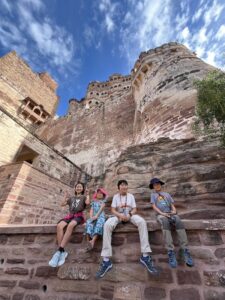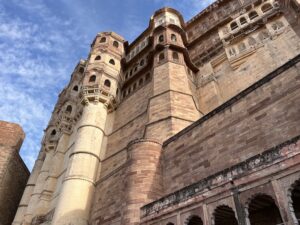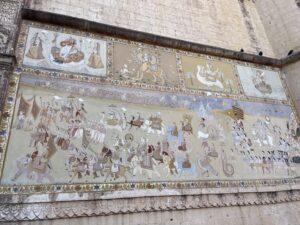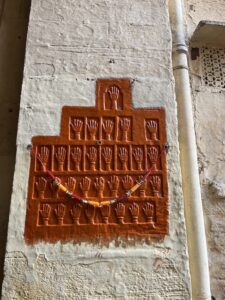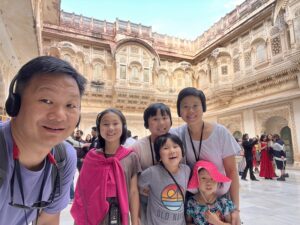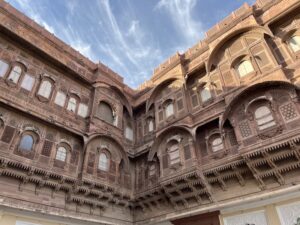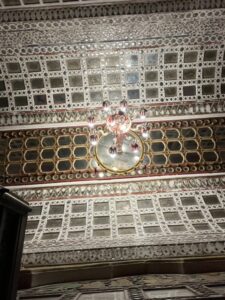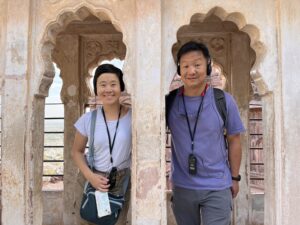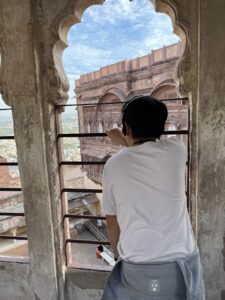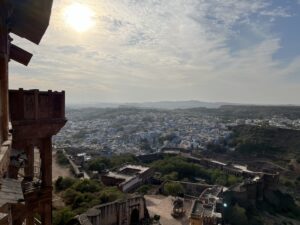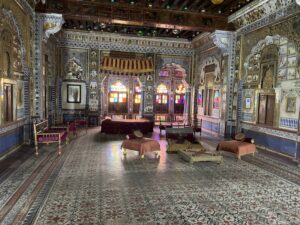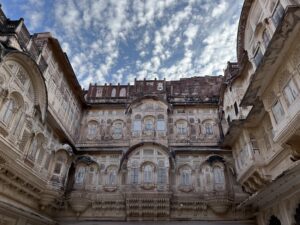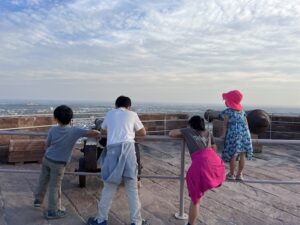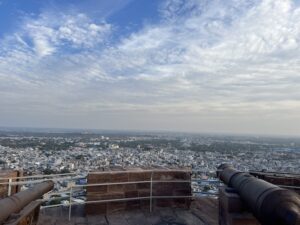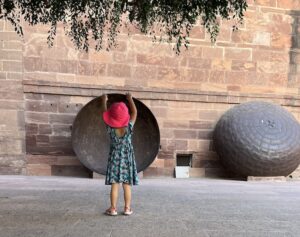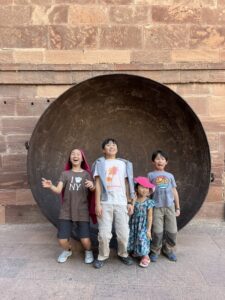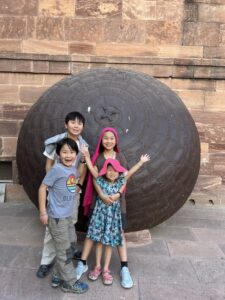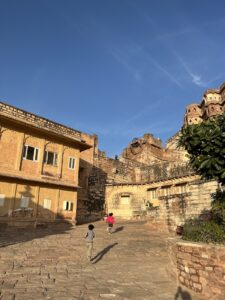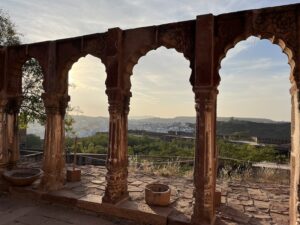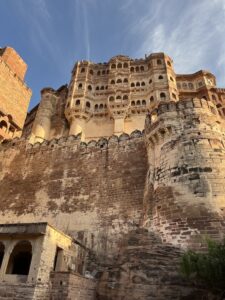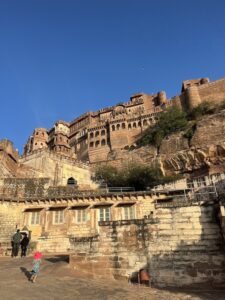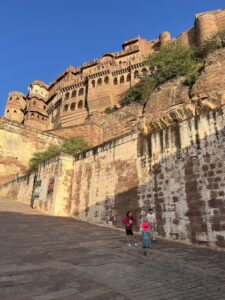Mehrangarh Fort casts an imposing presence over all of Jodhpur. As most of Jodhpur is relatively flat, the Fort, standing on hill nearly 120 meters above Jodhpur, can be seen from all around town. Mehrangarh Fort is the largest and one of the most impressive forts in India. That is saying a lot because every major city in India seems to have multiple palace forts. We have visited several forts during our trip including the Red Fort in Delhi, Agra Fort, Amber Fort and City Palace in Jaipur and City Palace in Udaipur. Although we were just scratching the surface when it comes to forts in India, it did feel like we had visited a lot of palace forts because they were starting to blur together. And it wasn’t lost on the kids that his was yet another fort.
Despite low morale, we couldn’t in good conscience miss the opportunity to see the most magnificent fort in India. We discussed as a family and agreed to go to Mehrangarh Fort for an afternoon visit. We conceded to the kids that we would not hire a local guide at the entrance and would just enjoy walking around the fort on our own.
It did seem to be the right choice to go in the afternoon because there were less people than others forts we have visited. At the entrance, tickets for foreigners were sold at a different table than tickets for Indian nationals. Luckily, we were the only foreigners so there was absolutely no waiting in line. We were also pleased that foreigners were offered a free English audio guide with handsets. We really couldn’t ask for more.
The approach into the Fort seemed particularly magnificent, more so than the other palace forts. But I think it had less to do with the Fort itself and more to do with the perfect lighting from the afternoon sun and the absence of people and pollution that allowed us to enjoy the ascent in our own time. From where we were standing, it actually reminded me of the giant’s castle in the clouds in Jack and the Beanstock. The Fort appeared to grow out of the rocky outcrop and reach toward the sky. We learned that the sandstone used to build the fort was harvested from the hill itself, so the fort and the hill upon which it stands blend into each other and appear to be one.
Audio guide in hand, we listened to the grisly story of how Mehrangarh Fort came to be. The construction of Mehrangarh Fort was begun by Roa Jodha, the 15th Rathore ruler of Marwar, in 1459. Legend has it that during construction, a grumpy hermit who lived in the mountain and who’s life had been disturbed by the building, cursed Maharaja Roa Jodha and his kingdom. In particular, he cursed the land with drought. Soon after, the hermit’s curse came to be and the land was plagued with drought. One of the nearby residents volunteered to sacrifice himself to appease the gods. In exchange, he requested that his family and descendants be taken care of for the rest of eternity. Roa Jodha accepted the offer and the man was buried in the foundation of the fort. To this day, the man’s descendants are provided for by the royal family of Jodhpur.
With the legend in our minds, we walked through the Loha Pol, Iron Gate, and learned about the red handprints that are found on the wall just past the gate. These 15 handprints could easily be overlooked but once we learned what they were, I doubt we could ever forget. These were sati marks, the handprints of the 15 widows of Maharaja Man Singh imprinted on the wall after his death in 1843 and before they threw themselves on his funeral pyre to be burned alive. It is said that sati was an act of loyalty and devotion for widows to follow their husband and king in death, as in life. Sati was a Hindu practice and continued as a time-honored tradition in Rajasthan into the mid-20th century, although it had already been outlawed by the British in 1829. We were shocked to learn that sati continued into our lifetimes until the Indian government officially condemned sati in 1987 with the Commission of Sati (Prevention) Act.
We loosely followed the guided tour but skipped over quite a lot of stops when they didn’t appeal to us. We spent some time looking through the galleries of the Daulat Khana. In the past, the Daulat Khana could have been used as a treasury or for other purposes. Today, the building contains the best-preserved objects from the Fort’s 500-year history including arms, textiles, paintings, manuscripts, decorations, palanquins, objects of daily use and much more.
After the Daulat Khana, it was a one-way tour through the halls and palaces of the Fort. First, we encountered the Sheesh Mahal, or “palace of mirrors”. We had seen another Sheesh Mahal in Jaipur at the Amber Fort. Mirror palaces must have been a trendy thing for maharajas in the day. This one seemed smaller and felt more private. The design of the Sheesh Mahal was to cover the entire interior, floor to ceiling, with mirrors such that with the light of a single candle, the entire room would be illuminated by the reflections created by the numerous mirrors. Oddly, we noticed a panel of mirrors that was laid on the floor of the mahal. This was the original 18th century mirrored ceiling that fell down and was later replaced with a new ceiling, together with the addition of European glass chandeliers in the 19th century.
A few steps brought us to the Phool Mahal, or “palace of flowers” also known as “pleasure dome”. This hall was obviously very grand and lavishly decorated with an ornately carved wooden ceiling, generous gold leaf, stained glass windows and painted walls depicting scenes from Indian classical ragas, royal portraits and Hindu gods. The Phool Mahal was where the king and his male guests came to be entertained by dancers and musicians.
While the interiors were grand, even more so were the courtyards that allowed us to see the fort in front of a backdrop of the impossibly blue sky dusted with scattered clouds.
Next, we entered Sileh Khana for a quick browse. On display are the weapons used by the Rajput warriors of Mehrangarh over the past few hundred years. There are swords, daggers, guns, shields of unique shapes and proportions.
Takhat Niwas was essentially the bedroom of Mahraja Takhat Singh (1843-73). It is sparse in its furnishings but the wall and ceiling paintings and carvings were particularly ornate with both British and Rajput styles represented in the architecture and decorative effects. There are paintings depicting scenes from famous Hindu myths beside portraits of European aristocracy. A feature of the room that might appear out of place are the Christmas-like decorative globes hanging from the ceiling. These globes were apparently giftts from the Queen of England to the Maharaja. Takhat Singh was the last of Jodhpur’s Maharajas to live in Mehrangarh.
We walked into a long hall filled with ridiculously ornate and embellished cradles that once rocked royal babies to sleep. This hall is the Jhanki Mahal and it is where women in the royal family observed processions and activities in the courtyards below without being seen. The lattice windows allowed the women to see out, but outsiders could not see in. As we learned in City Palace of Jaipur, this was the practice of “purdah” – shielding women behind screens and veils from male strangers.
We wandered through a few other rooms and then exited to stroll through the ramparts that offered a mesmerizing view of the city below. The kids were tickled to find on display two gigantic cooking pots that was once used to cook for huge crowds during religious festivals and royal celebrations. The pot was large enough to contain all of the kids and they had a lot of fun making EY pose such that through forced perspective, the pot appeared as a disc just slightly bigger than her.
Pleased with our visit, we wandered down the hill toward the exit. The children raced down, elated to have endured yet another visit to an Indian fort. On the way down, we took a wrong turn and stumbled upon an administrative area that perhaps was once a garden. It looked like it had been overlooked in any restoration efforts, but the archways and pergola were incredibly beautiful in the golden light of the afternoon.
We said goodye to Mehrangarh Fort and followed the path back down toward town. Every step and every turn afforded us slightly different views of the magnificent fort. There was no sign of the heavy and sometimes gruesome history of the fort as it was hidden inside the walls and underneath the foundation. The setting sun reflecting its golden rays off of the sandstone walls of the fort gave it a truly magical feeling.
Not yet ready to head home, we searched for Mishrilal, a dessert shop called that we had learned about on an Indian Youtube travel video. More so than the rest of us, Leo was intensely keen to try a famous treat in Jodhpur called Makhaniya Lassi. According to the Youtuber, the Makhaniya Lassi at this shop is world famous and a “must-try” in Jodhpur, especially to cool oneself off in hot weather. It is unlike other lassis in that it is extra thick and must be eaten with a spoon. It is flavored with saffron, cardomom and rose-water. To make it even richer, it is topped with yogurt-cream and hung curd and then garnished with cardamom seeds, pistachios and saffron.
We found the shop in the main square beside the clock tower. It was doing brisk business with what appeared to be a quick-moving line. We proceeded inside and found a seat at a shared table with a couple from the Punjab region. Leo ordered the Makhaniya that was served in an attractive tall glass. It had the texture of Greek yogurt or sour cream and was intensely sweet with a rich aromatic flavor coming from the combination of rose water, cardamom and saffron. Leo really liked it, but the kids and I didn’t care for it as much. Obviously we were in the minority because when we looked around, pretty much everybody else in the shop ordered the Makhaniya and they were scraping the bottom of the glass with their spoons to make sure they enjoyed every last drop.
The kids and I ordered the more familiar mango and strawberry-flavored lassi that was served in boring plastic cups. Although I have never been a big fan of Indian desserts because they are all so sweet and some of the flavors can be overpowering, we ordered a few desserts to try because it seemed like the right thing to do in this special shop with a nearly 100-year history.
Author
-

Song is the mother of four children. She and her family have stepped away from it all and in September 2023, began traveling the world while homeschooling. Song is an ABC (American born Chinese) and has an undergraduate degree from Cornell and an MBA from Harvard. She is an entrepreneur and an educator. Her hobbies include learning, traveling, reading, cooking and baking, and being with children.



